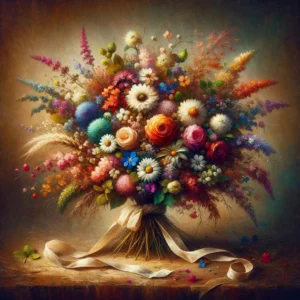Discover the enchanting world of What is a posy flower?, their rich history, and symbolic meanings. Learn how to incorporate posies into your life for meaningful expressions.
Introduction: The Timeless Appeal of Posy Flowers
Imagine a bouquet so small it fits in the palm of your hand, yet so intricately arranged that each bloom, each twist of the stem tells a story. This is the essence of posy flowers—a miniature garden of emotions, history, and beauty. Posy flowers, often interchanged with terms like nosegay or tussie-mussie, represent more than just floral arrangements; they are historical artifacts, laden with symbolism and capable of conveying the deepest of sentiments without a word spoken.
The Historical Journey of Posy Flowers
The journey of posy flowers begins in the medieval era, where they served pragmatic purposes—carried to ward off diseases and unpleasant odors, given the lack of modern sanitation. As we traverse to the Victorian era, posies evolve into a sophisticated language of love and courtship. In a society where direct expression of feelings was often frowned upon, a posy allowed secret lovers to communicate. Each flower, each color held a specific meaning—a secret code known only to the giver and the receiver.
The Art and Symbolism of Posy Flowers
At the heart of posy flowers lies a complex language of symbolism. Red roses for love, white lilies for purity, lavender for devotion—the list is as endless as the spectrum of human emotion. Crafting a posy is akin to composing a poem; each selection and placement of flower carries weight. This symbolic language, known as floriography, allowed individuals to express feelings of love, sorrow, or even disdain, without uttering a single word.
Crafting Your Posy
Creating your posy flower arrangement is a deeply personal and creative process. Begin by selecting flowers that resonate with the message you wish to convey. Consider the seasonality of flowers to ensure freshness and vibrancy. As you arrange your posy, think of it as a canvas—your hands weaving together not just blooms, but a tapestry of emotions and stories. Binding the posy is an art in itself, traditionally done with doilies or ribbons, adding the final touch to your floral masterpiece.
The Role of Posies in Modern Life
Today, posies have transcended their historical roots to become a modern expression of individuality, emotion, and aesthetic beauty. They are no longer just for lovers or secret messages but have found their way into everyday life. A posy can be a centerpiece at a dinner party, a thoughtful gift for a friend, or a bride’s bouquet, symbolizing her hopes and dreams for the future.
Posy flowers, rich in history and symbolism, are more than just aesthetically pleasing arrangements; they are a language in themselves, conveying emotions and messages without words. Let’s delve deeper into what posy flowers symbolize and the meanings associated with their colors.
What Does the Posy Flower Symbolize?
Posy flowers, historically known as nosegays or tussie-mussies, have been a symbol of affection, sentiment, and even protection across cultures and eras. In the Victorian era, posies were especially significant, as people used the language of flowers, or floriography, to express feelings and communicate messages discreetly. Each flower and color in a posy carried a distinct meaning, allowing individuals to convey complex emotions and messages in a socially accepted manner.
Meaning of the Posy Flower Colors
Red Color
Red posies are perhaps the most universally recognized symbol of deep and passionate love. The intense hue speaks of desire, courage, and respect, making red posies a popular choice for romantic occasions. Beyond romantic love, red flowers in a posy can also represent admiration and respect, making them versatile for various expressions of affection.
Yellow Color
Yellow posies radiate happiness, joy, and brightness. This color, often associated with the sun’s life-giving energy, is perfect for lifting spirits and spreading positivity. Yellow posies symbolize friendship, trust, compassion, and respect, making them ideal for celebrating platonic relationships and expressing care and support.
Pink Color
Pink posies are tender expressions of happiness, gentleness, and femininity. They often carry meanings similar to red but with a softer, more delicate sentiment. Pink flowers can signify admiration, grace, and gratitude, making them suitable for expressing appreciation and fondness.
Orange Color
The vibrant orange in posies signifies excitement, enthusiasm, and warmth
What does the Posy flower symbolize?
Posy flowers symbolize a myriad of sentiments and virtues, from love and joy to remembrance and purity. Through the language of flowers, or floriography, posies convey messages between people, often in a discreet and elegant manner.
Conclusion
The allure of posy flowers lies not just in their beauty, but in their ability to carry forward traditions, memories, and the silent language of the heart. They remind us that in a world of incessant noise and haste, there remains a place for the quiet beauty of a posy—a small, but profound reminder of the power of flowers to convey what words cannot.
FAQs about Posy Flowers
Q: Can any flower be used in a posy? A: Yes, virtually any flower can be incorporated into a posy, provided it fits the overall size and theme of the bouquet. The choice largely depends on the message you wish to convey and personal preferences.
Q: How do I maintain a posy flower bouquet? A: To ensure longevity, trim the stems at an angle before placing them in water, avoid direct sunlight, and refresh the water daily. A cool environment can also extend the life of your posy.
Q: Are posies suitable for all occasions? A: Posies are incredibly versatile and can be customized to suit any occasion, from weddings to memorials, making them perfect for expressing a wide range of sentiments.
